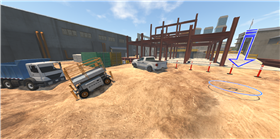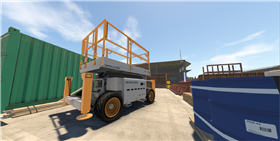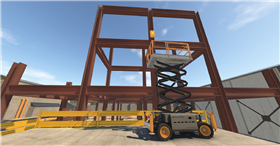Getting serious about training
01 May 2018
Serious Labs was originally founded in 2005 as 3D Interactive Inc., also known as 3DI. 3DI was focused on developing 3-D modeling and simulation for heavy equipment training. In 2012, a combination of new executive leadership, new investment and new technology refocused the company on game-based and virtual reality (VR) training. The company’s branding also changed to Serious Labs at that time. Based in Edmonton, Alberta, Canada, Serious Labs now employs 45 people and is changing the way training can be provided. Jim Colvin, the company’s chief executive officer, is passionate about safety and training – and his passion speaks volumes. We spoke after the company debuted its scissor lift training simulator in early March. Here’s what Colvin had to say.
ALH: Talk to me about how Serious Labs was founded.

Jim Colvin: Game-based learning is often referred to as “serious games” and a lot of research and development is required to be an innovative technology company similar to a laboratory. We have since been focused on safety training and operator competency within the construction, mining, and oil and gas industries.
Our guiding mission is to shape a safer, more engaged global workforce. We offer VR training and assessment simulators for cranes and added a scissor lift module to our boom lift simulator to deliver the world’s first Mobile Elevated Work Platform (MEWP) simulator which we just introduced in March at the IPAF Summit in Miami.
Our approach is to collaborate with manufacturers and industry experts to create a diverse solution to develop and expand their training offerings. We have strong partnerships with United Rentals and their United Academy training, ITI for crane training, and we recently announced our collaboration with Skyjack for the new scissor lift portion of our MEWP Simulator.
Why did Serious Labs choose access equipment (and/or how was it chosen) simulators?
Developing a training simulator for the access industry was a great fit for our capabilities. Access equipment is one of most common and most dangerous types of equipment that is utilized on a worksite. Equipment such as boom lifts and scissor lifts are responsible for a high percentage of incidents, injuries and deaths on worksites, and the majority of those incidents can be prevented through operator training. Typically, training on access equipment is “just enough, just in time” in order to get the skilled worker to height to perform their job as soon as possible. And sometimes, it doesn’t happen at all.
To truly understand someone’s abilities to operate a piece of equipment efficiently and safely there has to be a way to test and measure them in a complex environment without risk. The MEWP simulator affords this ability and reveals the gaps in operator skill level.
What has the response to the boom simulator been?
It has been phenomenal. The immersive nature of the experience has convinced even the hardened “old school” trainers and operators. And that response led us to develop our new MEWP simulator, which combines both the boom lift and scissor lift modules. The simulations isolate tasks around driving, lifting, platform positioning and operating. Each module takes about 45 – 75 minutes. The MEWP simulator comes with our Simulator Motion Base that makes you feel just like you are moving on an actual work platform.
How many simulator units (for access equipment) do you have out in the world? Will this increase this year? If so, by how many?
While we are increasing production to meet demand, we are also educating the industry on VR and the integration of simulation in training and assessment. We have worked on an economic model which has been designed to support the smaller training companies as well as our larger reseller partnerships.
We are committed to making the MEWP simulator available to all workers, and that includes both the cost of the MEWP simulators for training and rental organizations, as well as where workers can go to access them. We are already in talks with like-minded companies, like Skyjack, to help ramp up our manufacturing output, and United Rentals and Nationwide Platforms to make the simulators available. Those types of partners who also share the same commitment to safety as we do will help make training commonplace.
Why is VR/AR important for the access industry?
Wow, that’s a very good question. To start with, there is a massive global shortage in skilled labor right now. The Boomers are currently being replaced by Millennials who learn differently.

We believe that today we are faced with a new digital workforce. These are game, Internet and smart phone power-users who expect to be engaged by training technologies rather than the traditional classroom methods. Simply putting a PowerPoint on a screen, or courses online, is not enough now. They prefer game-based learning where they can be immersed in a jobsite and learn by doing.
And, by being able to immerse a trainee into a dangerous situation risk-free, it gives them an actual worksite experience that can’t be replicated in real life. By letting them make mistakes in a virtual world, they learn respect for the equipment and learn the right way to operate it which makes them safer and more competent at the same time.
North America, in particular, has a different training culture than Europe, for example. In Europe, aerial training has been utilized and pervasive for decades, largely driven by regulatory reasons. North America has more of a cowboy mentality where operators often are not trained and just get right on the equipment, or they haven’t been trained thoroughly and still don’t know how to operate it in certain risky situations.
The United States does not have the same type of enforcement of specific laws as the UK, for example, yet incidents, injuries and deaths are common. The new ANSI standards will impose stricter guidelines around training now, but are the standards enough to make training mandatory? No, they aren’t. But it comes down to the ability to provide everyone with access to quality operator training so they can go home at night in the same condition as when they showed up to work that morning. Everyone, from every walk of life, is entitled to that.
I think some operators don’t even know how dangerous their jobs are, or that they even need training, because it isn’t mandatory in many cases. Not only is it important for people to do their jobs productively and efficiently, but safely too. And that goes not only for the operators, but also for the employers, and it helps keep even the public safe that could be hurt in an accident as well.

We are working on a study right now to show that proper training is more than just a moral obligation of the employer; training is a sound business investment as well. And that is also why it’s so important to us to try to make training available at a price point where anyone can afford it and anyone can access it. Training is one of the most important ongoing issues facing the access industry right now, and we want to help be part of the solution.
What benefits does your system offer vs. in-person options?
Simulators have many benefits. They offer the ability to practice skills in real-world situations before being tested on the actual equipment. The training scenarios are always objective, consistent and scalable; they do not require human intervention enabling greater throughput. They are also measurable, so every behavior including ride quality, controls manipulations and where the operator is looking, is measured and recorded.
Will AR/VR replace in-person training? Why or why not?
That’s an interesting question. AR/VR for training and assessment, combined with online theoretical training, is capable of eliminating in-person classroom training completely. However, some form of in-person final assessment and familiarization with the actual equipment will still be required, and for some, a classroom environment (coupled with time on the VR simulator) may be the preferred experience. To us, it’s about providing options to the trainee that ensure that he or she receives the best training possible using the latest proven methods and tools.
You just introduced scissor lift simulators; what’s next?
We are currently scoping a counter balance and rough terrain forklift, followed by a skid steer and front-end loader to create our next simulators. These will all be available on the same universal motion base.
What do first-time users express after their initial trial with your system?
Total surprise and shock at the realism and immersive nature of the experience via the VR headset and the full motion base! First time users often forget they are not actually at height, and will hold on for dear life, lowering the boom before stepping off. That’s always a good response! It truly does feel that real.
How did the partnership with United Rentals come about?
We were originally put in touch with Jim Dorris, the new VP of HSE at United Rentals, back in 2012. Jim’s vision was to offer the heavy industry a single portal where they could purchase, book, receive and track the best available operator training using the latest modalities to delivery it.

What future partnerships can we expect from you in the access/rental sector?
Serious Labs is already in discussions with the major access rental firms to make our VR simulator solutions available to a global market, either as a new asset in their rental fleets or through value-added training solutions delivered through branch-located and mobile training centers.
Anything else?
Serious Labs is humbled by the incredible response to our VR solutions, and we are in awe of the commitment that so many of the OEMs, rental companies and training providers have to the safety and competency of workers operating at height. We look forward to continuing to explore and leverage leading-edge technology to deliver the most effective training and assessment tools to the heavy equipment industrial worker. After all, everyone deserves to come home to their families the same way they arrived at work.




